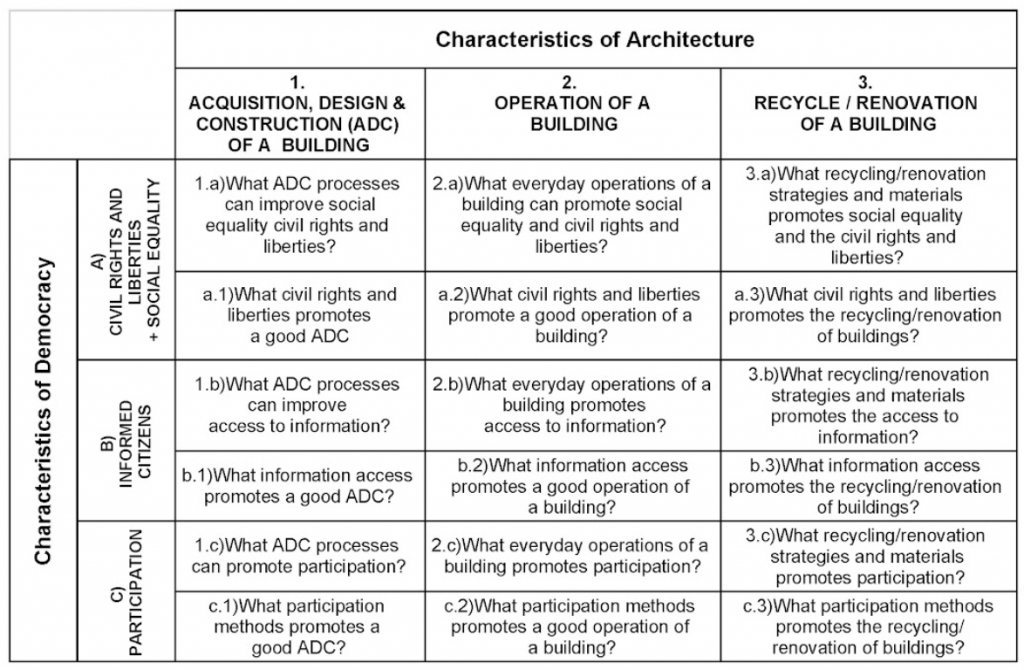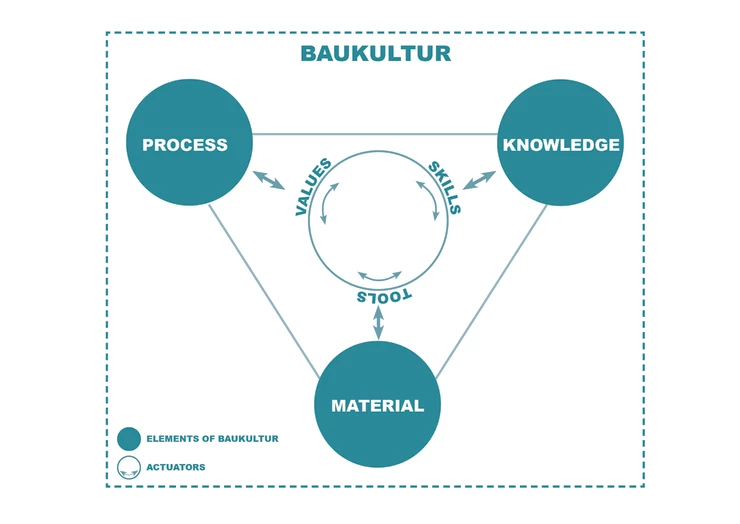Pedro Esteves Galvão Aibéo
Ph.D Candidate at the School of Engineering
Aalto University
pedro.aibeo@aalto.fi
www.aibeo.com
Highlight Legend
@@@Baukultur@@@
iiCraft/Craftsmanshipii
@@(Digital) Tools@@
ii@@@Values@iii@@
iiii@@@Skillsi@ii@@
iiii@@Processesiii@@
ii@@Knowledgeii@@
ii@@@Materialiii@@
Introduction
Architectural Democracy is an ongoing Doctoral Research at Aalto University, exploring the relationships between Architecture and Democracy. A three by three matrix is being proposed where 18 pertinent questions about such relationships are testing the validity and usefulness of such a matrix, among the different stakeholders.

This research is focusing on how people can understand cities, with its increasing automatisms, and how one can still be relevant for the decision making of these. If automated democracy persists due to the steady increase of complexity of cities, what are the roles of citizens? Will we not simply become subjects, unaware of what is going on and why, and therefore be alienated from any relevant decision-making processes and therefore power?
Researcher and Research Background
My work around architecture and engineering took me to several countries around the world, from the Middle East to China, India or Mexico. For example, I was involved in the work of the Elbphilarmonie in Hamburg. Does such a building represent the spirit of baukultur? From my work experience at Bauhaus Dessau in 2009, and later in my practice as an Architect and as a Civil Engineer in 10 countries, Baukultur means an holistic take of the process of construction, its processes and outcomes, for a sustainable society. The elbphilharmonie process was tarnished by a controversial budget slip. The reasoning for such slips is very different from what the public is aware of and what I know as a former worker of that company which designed it. Committed to a commercial agreement of non disclosure of office praxis, me and my colleagues are unable, for life, to reveal what we know or knew. The realization that a construction process has indeed different colors and perceptions for the different stakeholders is of relevance here. How can we cherish a baukultur, a creation of an ethos for both a place we want to live in and the process involved in its creation, if secrecies (due to conflicts of interests) damage it so often?
The construction processes I have been involved in during my career, specially in Oman, Russia and Switzerland, made me realize that the regular “green washing” of the construction industry may be steadily increasing the waste and corruption, the destruction of heritage and bribery patterns all over the world. Such patterns are seemingly well established in every country I worked at, most surprisingly in Switzerland, a society obsessed with transparency. The method or tools are different in each country, but the process is maintained, the return of investment, and build fast to profit fast.
Baukultur
The relationship between process, knowledge and material is of high interest, first and foremost for me, from a negative perspective so that one can improve it.

I’ll be the pessimist here. The current values of the process are not of a moral architecture as Ingenhoven would defend. The process of construction follows far more a Philip Johnson’s “I am a whore” process. Architects and engineers’ values are corrupted by a corporate process of fast profits. If Robert Park’s words matter, in that the kind of people we want to be is the kind of cities we should be designing for, then we are creating profit driven people, whose values mirror that stance.
The knowledge required to excel in the construction industry could be speculatively described as 20% design skills and 80% team player skills. Team here being the company, not your own design team. The design team, your fellow colleague can never be seen above the corporation. The skills we are developing here, are once again towards a society where the individual relationships deteriorate in favour of the survival of an abstract entity, the company. How can we overcome this damaging conflict, between corporate loyalty and the individual morals?
The construction industry is the least innovative and likely the most pollutive of them all. Baukultur would require craftsmanship but one has instead a mechanical practice. There is a difference between a craft practice and a mechanical practice. In Richard Sennet’s words, a craft practice requires slow pace, allowing a consciousness of the activities performed. But to produce something fast, shifts the burden of craftsmanship to the consumer. The concept of feedback mechanism creates poor feedback and poor products as it is based on a poor fast initial proposal. But what if the design questions are posed in a more holistic way, requiring slower thinking?
In this work of Architectural Democracy the proposed matrix is at the same time reducing complexity around the two fields to make it more understandable. Could such a matrix thus respond to the ongoing problems of a sclerotic baukultur?
The proposed process tests the usefulness of the matrix at first at a very basic level, by comparing the questioned people before and after the awareness of the method. To see what changes occur in the quality of the answers, what degrees of awareness change and of the complexity of the urban environment change, when confronted with harder questions, but contextualized around an understandable framework.
If we wish to think of a baukultur, now at the crossroads between the analog and digital, one that should be implementing values, skills and tools towards a sustainable society, then we ought to address the processes more than its outcomes. The process of baukultur is deeply ingrained with the social agreements we have made between workers and companies, between the individual and the collective, between the secrecy of knowledge of the group and the transparency of the processes witnessed by the individual.
